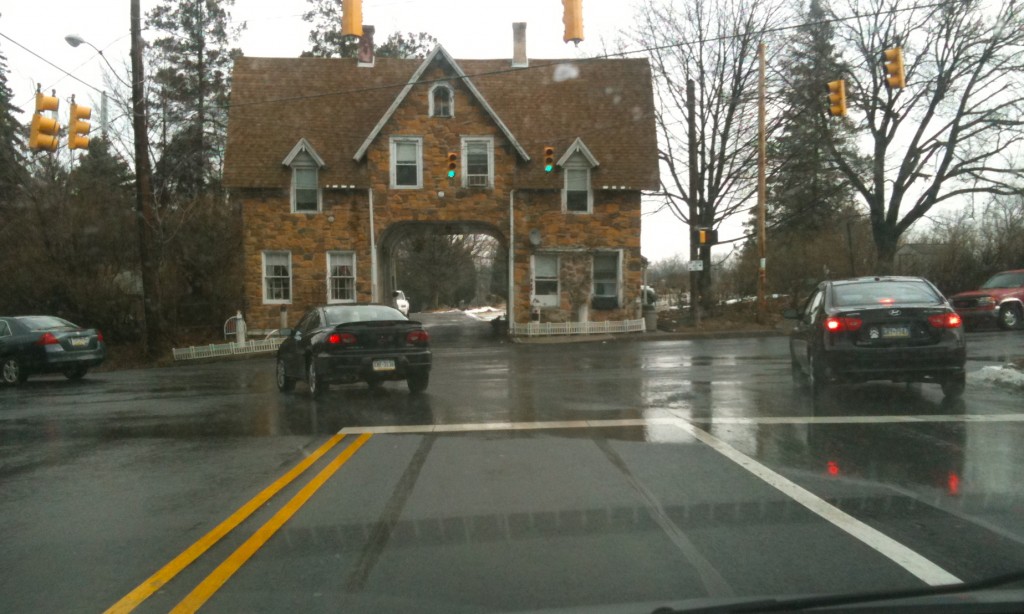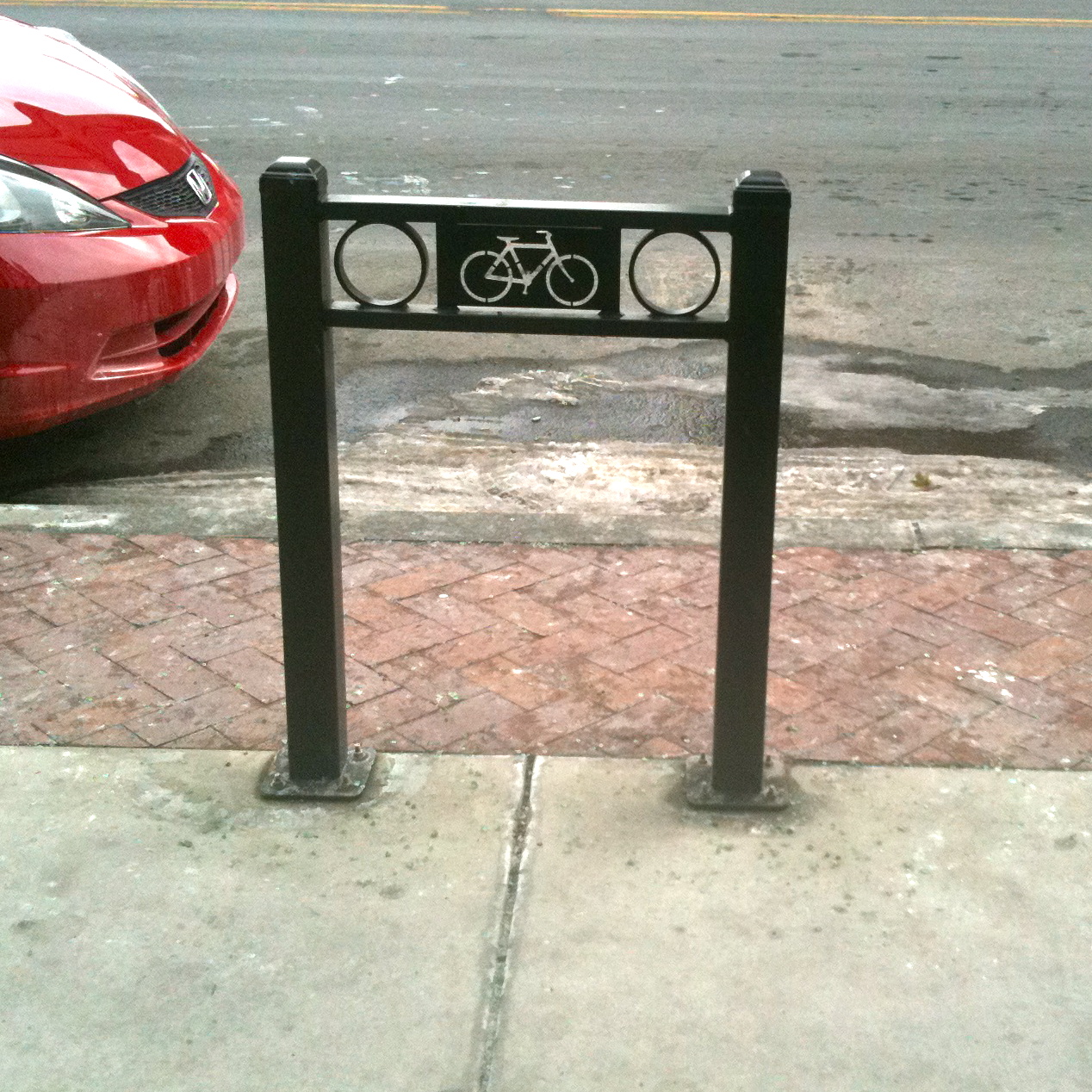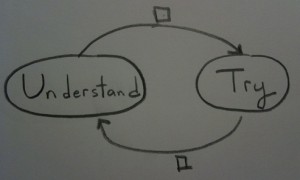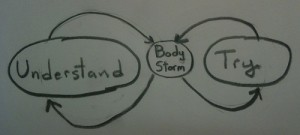This is next to Prospect Hill cemetery in Harrisburg PA at the intersection of Market St and Kline Village. A road runs right through the center of the house. Now the road is the road to the cemetery, not a main thoroughfare, but still I think that is remarkable. It brings to life a design thinking example of entertaining two different ideas in your mind at the same time. A house. And a road.
Archive for the ‘Uncategorized’ Category
Road that goes through the middle of a house
Wednesday, March 2nd, 2011Nice Design of a Bike Rack as Hitching Post.
Tuesday, March 1st, 2011About a block away from Red Privet offices, on Chestnut street right outside of the “Olewine’s Meat & Cheese House” in downtown Harrisburg is this great bike rack. I like the cut out image of a bike. Sometimes I see bike racks and they are just plain metal tubes that might be and might not be legal to lock your bike to. This design work well because it clearly is labeled for a bike with the cut out image of a bike.. It also recalls an old hitching post for horses.
My notes from “The Playwork Primer” by Penny Wilson
Saturday, February 26th, 2011The Playwork Primer by Penny Wilson (Alliance for Childhood 2009)
4 Sentence Summary
Playwork comes from serious professional efforts to support children’s playing. The first efforts were with adventure playgrounds in London which developed the profession of playworkers . Playworker support children’s play that is freely chosen, personally driven and intrinsically motivated. Play is important for children and youth and it’s deprivation has serious consequences.
(p5)
It may be helpful to think of an adventure playground as a Gesamtkunstwerk, or “total artwork,” a space and time where all one’s senses are engaged.”
(p6)
The first bomb-site adventure playgrounds were staffed by “wardens.” … One of the first adventure playground wardens, Pat Turner, wrote a book about his time as Lollard playground that he called Something Extraordinary.
Makes me think if something like this might be useful or valuable for Iraq or Afghanistan and how children are playing there.
(p7)
“A good playworker will have resources as readily available as a first aid kit so that if and when children come and ask for face paiting or a deck of cards these materials or their approximations can be furnished to them. What a playworker does not do is schedule events and say, “This afternoon we will be face painting and playing canasta. Then you will do 30 minutes of “keep fit” and then have a healthy snack.” This contaminates the play frame and corrupts the freely chosen, personally directed, and intrinsically motivated playing that children must experience.”
Makes me think of how I can do something like this in the workspace and as manager/leader.
(p11)
“The theories of complexity provide some interesting metaphors for understanding playwork. Arthur Battram describes an ideal state for a play setting by likening it to a wave. Before the wave breaks, there is stasis, order. After the wave breaks, there is turbulence and chaos. At the curl of the breaking wave there is a delicate balance between order and chaos. … Look at the curl of the wave, which is where we surf because that is where the power is … It is a framework for creativity.”
I want to surf!
(p13-14)
“Loose parts (Nicholson’s theory of loose parts) do exactly the opposite of battery-powered toys that require the child only to push a button to send the toy into an ecstasy of beeping and flashing a tinny music. Such toys do the playing while the child is reduced to the passive role of an audience.”
(p16)
“Have the best time that you can while you are here and try not to hurt yourself or anyone else.”
(p28)
“We are poor indeed if we are only sane.” by D.W. Winnicott
(p30)
“He terms the space between the GEM and the child, in which this playing occurs, the “transitional or potential space.” It is a space where things can happen that are “me” and “not me.”
This is bodystorming for me.
Brand to Customer Loyalty
Friday, February 25th, 2011How could companies be loyal to their customers? Call it “Brand-to-customer Loyalty.”
“Brick and Mortar Loyalty has meant customer loyalty to brick and Mortar, it has never had to mean brick and mortar loyal to consumer” – Chris Hall
Loyalty is shorthand for repeat usage and also an element of having a relationship
Loyalty in the sense of the business “celebrating” that they know the customer. Perhaps even giving them precedence over a new customer.
Loyalty might mean giving them special rights that new customers might not have such as a discount based on number of years as customer.
Loyal Customers are Happy Customers
One way to make happy customers might be to be “loyal” to customers. I know we usually think about customers being loyal to a company or to a brand. What would it mean if a brand was loyal to a customer?
A real world example at our local Mexican Grocery Store
They know us. We know them. Not just the cashiers. I mean, the cashiers, the owners, the cooks in the back and the waitress who serves us in the small little restaurant. They have even offered to extend us a line of credit. Allow us to open an account that we could pay each month.
Loyalty to us: Around the Christmas holiday they gave us a bag of treats. Not just a calendar, but some sodas, some chips, and some cookies, and some . Now we aren’t talking big bucks. But that was nice. And they weren’t giving it out to everyone. I liked that. Made me feel special and I could see they didn’t have a pile of pre-made bags with all the same items that they gave to each person.
See Also
Transform Your Loyalty Program from Bank to Park
Happy Customers and “The Curse of Knowledge”
Friday, December 31st, 2010Right now I am preparing a workshop to help a client who builds and sells physical products. We are helping them create a “device management” interface for one of their products. They want to make sure they will have happy customers.
Why do companies bring me in to help them? They are experts in their products. Why do they need our services to help ensure they will have happy customers?
Because of “The Curse of Knowledge.” Bob Sutton uses this concept to explain how to be a better manager, but I think it is valid for us to think about why clients need to hire or bring in experience designers.
“The Curse of Knowledge” as he explains it is “the more people know about something, the harder it is for them to package explanations and instructions in ways that others can comprehend.” In terms of customer experience and thinking about happy customers, this curse happens because experts, the companies and their employees, have a hard time putting themselves in the shoes of their customers. More important than happy customers, is being able to put themselves into the shoes of an unhappy customer or a first-time customer.
How can they “forget” their expertise and design an interface that embody simple tasks that allow their customers need to do. Simple means simple to know and simple to do. It should require minimum emotional and cognitive effort to turn what knowledge and needs the customer has into action.
I am using my business and industrial anthropology background to help this company see their own product in new ways, most importantly in the way their customer or a first time user of their product sees their product. It is like explaining the culture of a distant tribe to a group of people. More apropos than “explaining” is “translating.” One needs not only to be good at understanding their foreign tribe – the customer. But also to understand the client culture. Then figure out ways to translate the customer world-view into the client world-view.
References
Measuring Happiness in Usability Testing
Tuesday, December 21st, 2010Yes, you want happy customers. How in a usability test can you evaluate if your prototype experience fits together with a happy customer.
Tomorrow at Red Privet we are doing a round of usability testing. More/Better happiness is a valid and useful goal for software/service design. How can happiness be measured in a usability test?
In earlier work with the end-users we were able to map the experience in the image below. In the bottom half of the image you can see the ups and downs of error/problems as the end user would go through the stages of the journey. Then we asked the end user to put a smiley face on the the stage they were most happy at and a frown on the stage they were most sad at. In a similar way, I’ll ask “What part of the prototype that you just used was the most satisfying?” OR “What would be the high point and the low point of using the tools that we just went through?”
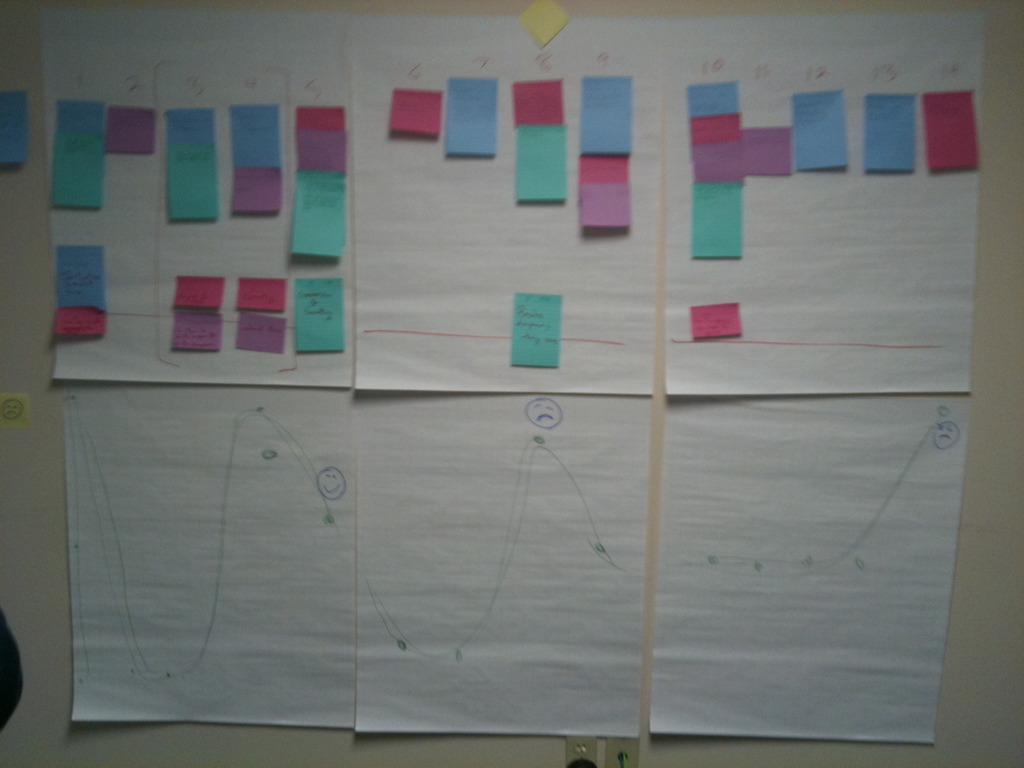
See Also
Notes on “In Pursuit of the Perfect Brainstorm”
Monday, December 20th, 2010Notes on “In Pursuit of the Perfect Brainstorm” by David Segal NYT Dec 16, 2010
“. . . its specialty is conceiving new businesses and what it sells is really the art of innovation.”
“America has gone meta – it has started thinking about thinking. And all that thinking has led many executives to the same conclusion: We need help thinking.”
“… without the right atmospheric mix, no brainstorming session will produce the cognitive version of lightning”
“… traditional brainstorming can devolve into a kind of competitive idea tennis.”
“ … improve theater . . ‘Yes, and?’ … what was once a contest is transformed into a group exercise in storytelling. It has turned into a collaboration.”
“ … strategy isn’t about stability, it’s about change.”
“For years, the good manager was one who had data at their fingertips … By the early ‘90s, though, companies like Microsoft and SAP were selling software that digitized this task … Suddenly it’s about leadership, creativity, vision.”
Reference
How to improve a wireframe/prototype review session.
Wednesday, December 15th, 2010Before you even start the review ask 3 questions.
- What kind of feedback would be most helpful for you, the designer, at this point?
- Do we all (anyone who is in the review session) understand the opportunity/problem? Don’t begin critiquing until everyone understands the opportunity or problem that it is addressing.
- At what stage is this review? Idea, Middle, or Final.
Then based on those answers ask the appropriate questions from one of the 3 sections below.
Idea sketch/stage?
- What job does this page do?
- What do you want someone to do after this page? Where do they go?
- What is the user’s goal on this page?
Middle Iteration Stage?
- What is the one thing on the page that generates the most value for the user? . . . for the business? How can you combine them?
- What can you make automatic? What do you know about the user so that they don’t have to think as much?
- Does the page pass the Push/Pull/Pass/Punt test?
Final Polishing Stage
- What can you remove? (Simplicity)
- How can you make “units” look more unified? Are the things that should be close together as close together as they can be? Are likely comparisons right next to each other?
- How can you enhance the one action/link that you most want people to use
See Also
4 Keys to a Successful Web Presence: Push, Pull, Pass, & Punt
My notes from The Laws of Simplicity by Maeda
How to Review Wireframes (one resource I was able to find that also addressed this topic)
Silent Choice of Click – Show everyone the first page of the wireframes. Ask each attendee to decide, silently, where their persona would click. Then discuss the choices and anything else you feel like discussing on that page.
When Social Objects meet “The Mesh”
Thursday, December 2nd, 2010“The Mesh” is mostly about physical (owned) objects that get shared. Social objects are objects that act as social “glue” between people.
I see the start of really powerful experiences when these two things are brought together. In Lisa Gansky’s book she gives that example of the Zip Car named “Mini Mucho” which is a example of a mesh object that is also a social object.
Social Object transformed into Mesh
Look at how social objects can be transformed into mesh objects (through time-sharing, such as a pet dog that gets rotated around a couple different families). What are all the ways we can time-split an object or place usage, such as a bank that during evening hours could be used for community gatherings? Or the use of corporate offices during the weekend for unconferences and barcamps.
Mesh Objects given an opportunity to build social meaning
How can mesh objects be given the opportunity to become social objects (through functions such as naming, tagging, graffiti, etc)? What are the ways we can use QR codes to give a “guest book” like quality to objects that get past around. For the tool library example – how about a list of all the projects that that tool helped to build (birdhouses, tree houses, book shelves, etc.)
References
The Mesh: Why the Future of Business is Sharing by Lisa Gansky (Thank you Mr Simborg for turning me on to this read.)
Bodystorming explained in visual diagram
Wednesday, November 10th, 2010Marc Rettig visually explains his “process” as understand and try with prototypes between them.
Bodystorming can thus be explained by extension as focusing on the “prototypes” or bodystorms as the central element of understanding and trying.
See Also
